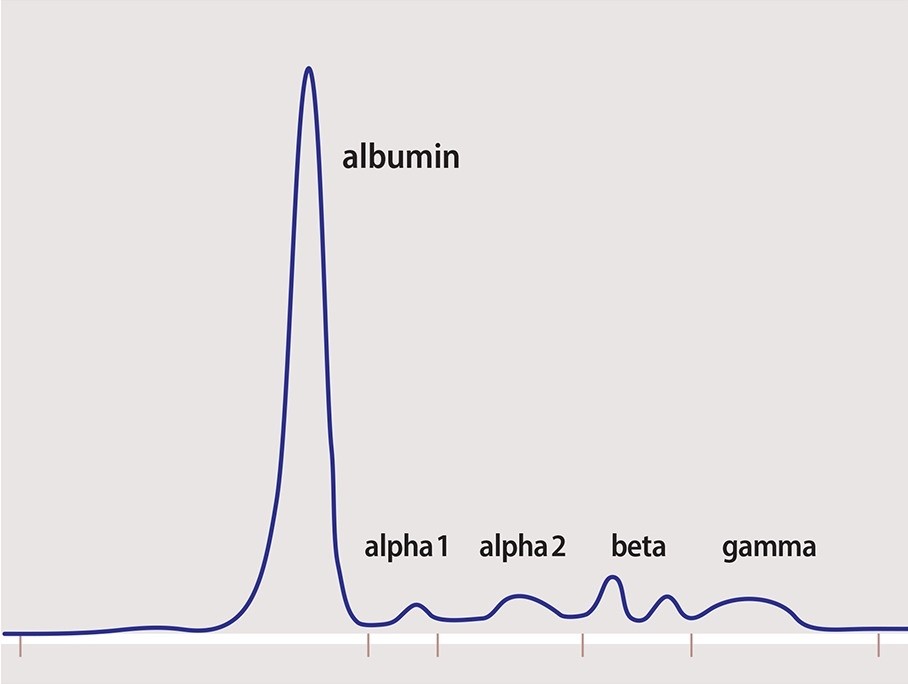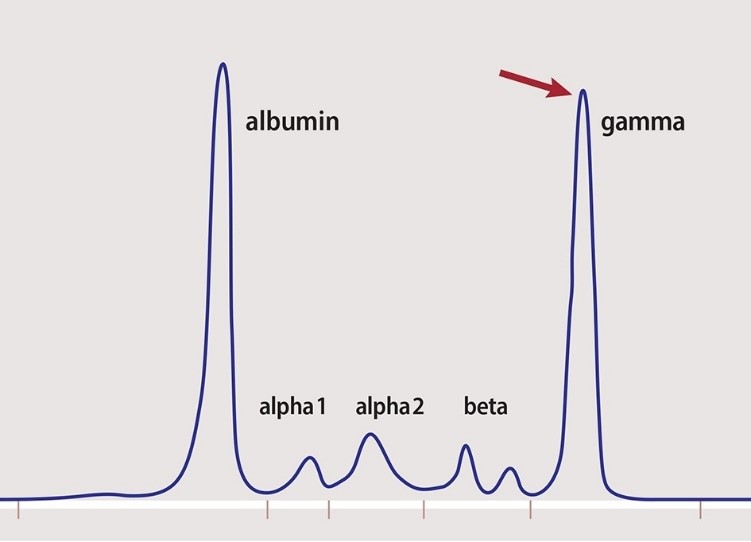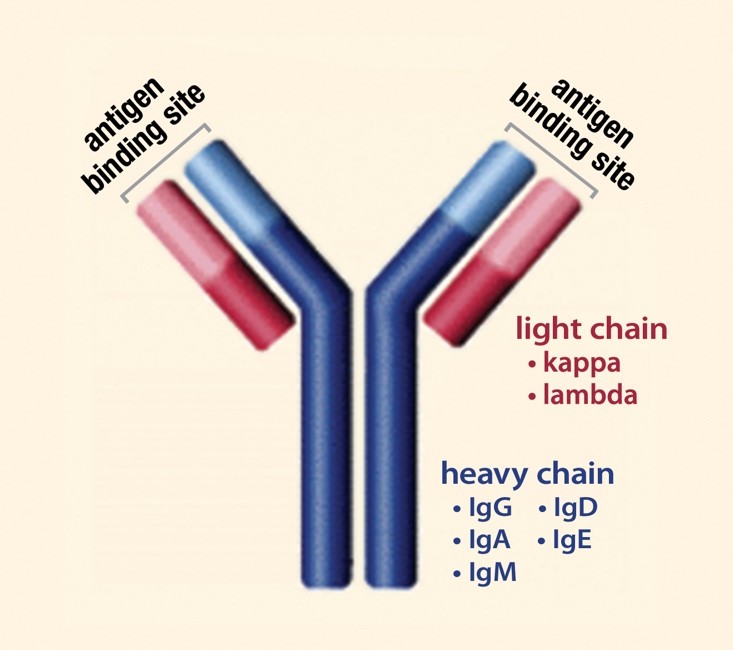This important group of blood and urine tests is used to assess the amount and activity of myeloma. These tests measure the monoclonal protein that myeloma cells secrete into the blood and/or urine.
Serum and Urine Protein Electrophoresis (SPEP and UPEP)
Serum protein electrophoresis (SPEP) is a test that measures the amount of heavy chain monoclonal protein made by myeloma cells. Learn more at Types of Myeloma.
SPEP separates all the proteins in the blood according to their electrical charge. Urine protein electrophoresis, or UPEP, does the same thing for proteins in the urine.
The first graph represents a normal SPEP result. It shows:
- a peak in the measurement of albumin (the most plentiful protein in the blood)
- lower levels of the other proteins, grouped into areas labeled alpha 1 and 2
- beta (with two bumps also known as 1 and 2)
- gamma, which is where the antibody proteins lie on the graph

The second graph represents the result for a patient with myeloma. In addition to the spike for albumin, there is another tall spike. The red arrow in the gamma region of the graph indicates this spike.
A pathologist measures the area under the spike, or curve, and subtracts the normal level of gamma globulins from the total. The result is your level of monoclonal protein (M-protein).

SPEP and UPEP tell us how MUCH monoclonal protein there is, but not the type. Monoclonal protein is the output of myeloma cells in most people with myeloma. Yet, every person’s myeloma is unique. The output of monoclonal protein can vary from patient to patient. It can also can vary in how that amount relates to the behavior of the myeloma.
SPEP and UPEP don't measure myeloma cells; they measure the output of myeloma cells. People’s myeloma cells don’t reproduce at the same rate or secrete the same amount of protein per cell.
A caveat with SPEP: Immunoglobulin A-type (IgA) myeloma monoclonal protein does not separate out in the gamma region of the graph. It can get “stuck” with the beta or even alpha proteins. Patients with IgA myeloma should discuss the best way to measure their monoclonal protein with their doctors.
Immunofixation Electrophoresis of Blood or Urine (IFE)
Immunofixation electrophoresis of blood or urine (IFE) is the counterpart to SPEP and UPEP. IFE tells us the TYPE of monoclonal protein in the blood and/or urine but not the amount. IFE testing separates proteins by electrical charge. IFE measures only the monoclonal — or abnormal —proteins, not the normal (polyclonal) ones
The result is either negative or positive for the presence of a particular type of monoclonal protein.
*Note: Darzalex can influence the results of IFE if a patient has IgG Kappa myeloma and is being evaluated for complete response. The patient may be in a very deep complete response, but a tiny band of IgG Kappa will show up on the test.
Quantitative Immunoglobulin Testing or QIg
Quantitative immunoglobulins testing is often done as part of early screening for MM. It is usually done if the total protein level is elevated. QIg measures total immunoglobulin protein in the blood, both normal and abnormal. If QIg detects an increase an immunoglobulin, you must undergo further testing with IFE. The goal is to see if the increase is from abnormal (monoclonal) protein.
Some doctors also use QIg to follow patients with IgA myeloma because it's difficult to assess IgA with SPEP.
Serum Free Light Chain Assay, or Freelite® testing

The serum free light chain assay (brand name Freelite®) is used for diagnosis and monitoring of myeloma. Immunoglobulin proteins are made up of two kinds of molecules, heavy chains and light chains (see diagram).
These heavy and light chains are usually bound together as “intact immunoglobulins.” For reasons we do not know, the plasma cells produce more light chains than heavy chains. The excess, or unbound, light chains circulate freely in the blood. Hence, they are called “free” light chains. These free light chains are present in both healthy individuals and in patients with myeloma and related disorders. Related disorders include:
- MGUS
- SMM
- amyloidosis
- light chain deposition disease (LCDD)
- Waldenström’s macroglobulinemia
Patients with myeloma may learn that their cells secrete:
- both heavy and light chains
- only heavy chains
- only light chains
Some patients, when assessed by SPEP, appear to secrete no M-protein at all. These patients' myeloma cells secrete no heavy chain protein, only a very small amount of light chain protein. The Freelite test is used for patients who
- only secrete light chains, which is often called “Bence-Jones myeloma." (The name "Bence-Jones myeloma is for the name of the doctor who first found and identified light chain protein in the urine).
- secrete both heavy and light chains
- secrete very low levels of protein, also known as “oligosecretory myeloma”
The Freelite assay is also used to:
- diagnose and monitor patients with MGUS, a non-cancerous elevation in monoclonal protein. The Freelite assay can help to assess if a patient's MGUS may develop into active myeloma.
- monitor patients with smoldering or asymptomatic myeloma (SMM).
For more information, read also Understanding MGUS and Smoldering Myeloma.
Serum Heavy/Light Chain Assay, or Hevylite® Test
The Hevylite® assay is a blood test that measures the intact immunoglobulins. It measures:
- the intact heavy and light chain protein made by the myeloma cells
- the heavy- and light-chain-bound immunoglobulin protein made by normal plasma cells
If your myeloma protein is, for example, IgA kappa, the intact immunoglobulin that is its normal counterpart will be IgA lambda.
Myeloma usually grows inside the bone marrow. Bone marrow tests (aspirate and biopsy) are performed routinely to diagnose and to monitor the disease.
The International Myeloma Foundation medical and editorial content team
Comprised of leading medical researchers, hematologists, oncologists, oncology-certified nurses, medical editors, and medical journalists, our team has extensive knowledge of the multiple myeloma treatment and care landscape. Additionally, Dr. Brian G.M. Durie reviews and approves all medical content on this website.
Last Medical Content Review: July 19, 2021







